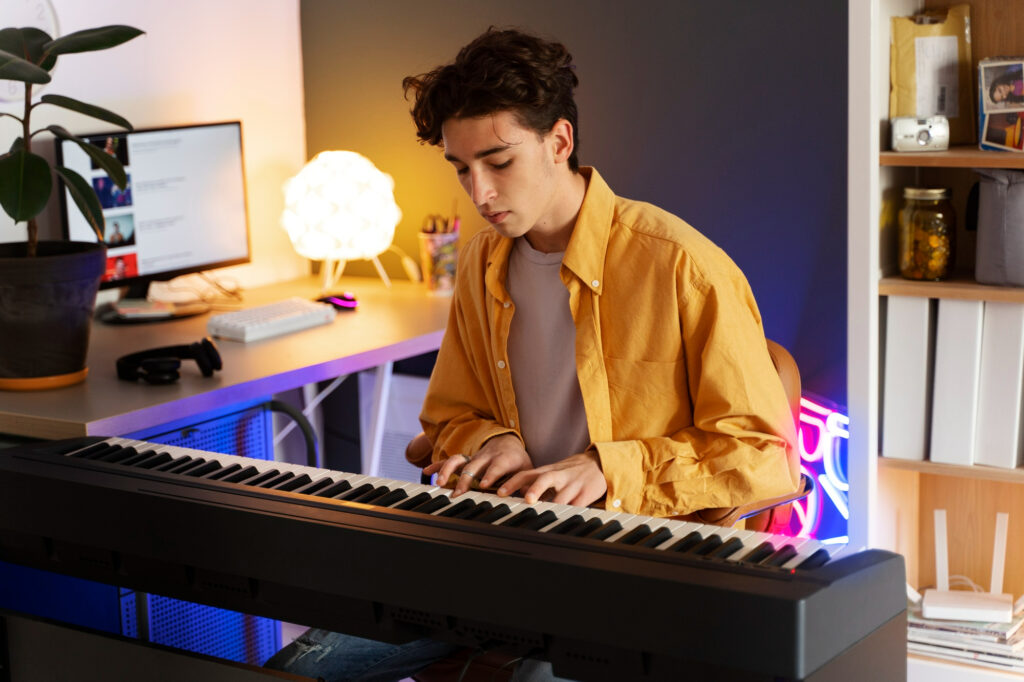Beginning to learn the piano is like setting off on an adventure: it’s super energizing but you’re bound to run into a couple of bumps along the journey. But don’t get stressed, getting past these intense parts is all part of the journey. A bit like learning to ride a bike, it might appear tricky at first with a number of wobbles and falls, but with practice, you will be riding better from day to day. And the best thing is that each small challenge you overcome makes you a lot better musician. So, let’s see how you’ll be able handle these obstacles head-on and make learning piano a ride to create memories.
Identifying Common Challenges
Learning to play the piano has its challenges. Some of these obstacles are common for many learners and solutions to them are also applicable for the vast majority.
- Getting the Notes Right: When you’re just starting, it can be like a game of Twister for your fingers, trying to hit the right notes. But don’t fret, everyone goes through it.
- Reading Sheet Music: It’s like learning to read all over again, but this time with a bunch of strange symbols on lines. It takes practice, but you’ll get the hang of it.
- Keeping a Steady Beat: Sometimes your hands want to do their own dance, and keeping them in time with the music can be tough. Like a heartbeat, the rhythm needs to be steady.
- Hand Coordination: Getting your left hand to play nice with your right hand is a common stumbling block. It’s like patting your head and rubbing your belly at the same time!
- Practice Time: Finding time to sit at the piano every day can be a challenge, but even a few minutes can make a big difference. It’s all about making it a fun part of your day.
Strategies for Overcoming Challenges
Now let’s surf in the possible solutions of these challenges and overcome them in the best and fun way possible.
- Slow Practice: When you’re in the process of learning to play piano, the notes can become tangled; in such instances, deliberately slow down. Play each note like you’re in slow motion. This gives your brain time to learn where your fingers should go.
- Break it Down: Sheet music can look scary with all those dots and lines. Try breaking it down. Learn a few symbols at a time, and soon you’ll be reading music like you read your favorite book.
- Metronome Magic: A metronome is like a ticking clock that helps you keep your music in time. Start with it ticking slowly, and as you get better, you can speed it up.
- One Hand at a Time: If your hands aren’t playing together nicely, just take it one at a time. Practice with your left hand first, then your right, and put them together when each one feels confident.
- Fun Schedule: Make a special time for piano practice, and stick to it like it’s the best part of your day. Add in fun songs that you love, and practice time will be something you look forward to!
Personal Stories and Testimonials
Like learning any new ability, learning to play the piano can have its share of difficulties. These are three first-hand accounts from people who have struggled and triumphed in their musical endeavors.
- Choosing a Piano Teacher: Finding the ideal piano instructor, someone with whom they can establish a strong relationship to guarantee learning in a method that works for them, can be difficult for some people. It is advised to look for qualified teachers on the website of the Music Teachers National Association, ask friends and family for references, or think about taking lessons at a nearby music store or piano dealer. Making an informed decision might be aided by reviewing sample lessons from several teachers.
- Learning to Read Music: Another common challenge is learning to read music, which provides the foundation for playing the piano. It requires understanding notes, key and time signatures, clefs, and dynamics. Although it can be difficult and takes time, mastering this skill is essential for a more enjoyable piano playing experience.
- Coordinating Your Hands: Coordinating both hands to play different parts of a piece can be quite challenging. It’s akin to doing any task that requires contrasting body movements and hand-eye coordination, like typing or driving. Practicing each hand’s part separately before combining them can build the necessary muscle memory for playing piano pieces with both hands.
Personal stories of overcoming these challenges can be inspiring.
Savannah Treviño-Casias talked about how her dyscalculia made math difficult for her to learn. She took on the task, understanding that although she was different, it did not make her any less. She was able to excel and obtain the Anne Ford Scholarship because of her mentality.
Jim Rein has dysgraphia, which causes serious handwriting difficulties, but he didn’t let it stop him from being creative. His ability to produce successful songs, a movie, and many articles was made possible by his computer skills, demonstrating that having trouble writing by hand is not a sign of intelligence or originality.
Stan Gloss would pretend to have asthma episodes in order to avoid going to school since he found reading and writing so difficult. But having his family doctor act as a mentor and making the connection between what he was learning and the reality. Accepting his dyslexia as a blessing, he went on to become a prosperous businessman, proving that overcoming learning challenges may result in extraordinary accomplishments.
During their learning process, each of these people had particular difficulties, but they all managed to adapt and get past them in order to succeed both personally and professionally. Their tales serve as a tribute to the strength of tenacity and original problem-solving techniques when faced with difficulty.
Resources and Support
There is a variety of resources and support systems that can help overcome the hurdles in our path of learning to play a musical instrument.
Online Piano Classes: They offer flexibility and a wealth of resources, but also come with challenges like technical difficulties and the lack of immediate feedback. Overcoming these challenges involves ensuring a stable internet connection, using video conferencing tools for active learning, recording performances for self-evaluation, and maintaining discipline with a regular practice schedule.
Persistence and Patience: Learning piano requires patience and perseverance. Progress can be slow, and it’s crucial to keep reminding yourself of your passion for music. The journey of learning the piano is also about developing valuable life skills like resilience.
Exploring Musical Genres: The piano is versatile and capable of expressing various musical genres, which can be highly motivational for students. Online classes can help learners explore different genres, from classical to jazz to pop, encouraging creativity and enjoyment in practice sessions.
These insights show that while challenges exist, they can be managed with the right approach and resources, leading to a fulfilling musical journey.
Final thoughts
Learning to play the piano is undoubtedly a journey filled with challenges, yet it is a path lined with equally rewarding milestones. While students may encounter obstacles such as finding a suitable teacher, mastering music reading, and coordinating hand movements, there are numerous supportive resources to guide them.
Online piano classes, for instance, provide flexible and comprehensive learning opportunities. Persistence and patience play key roles in overcoming difficulties, and the exploration of diverse musical genres can ignite a lifelong passion for music. Thus, while the road may have its bumps, the solutions and support available can make the journey of learning to play the piano an enriching and joyous experience.






